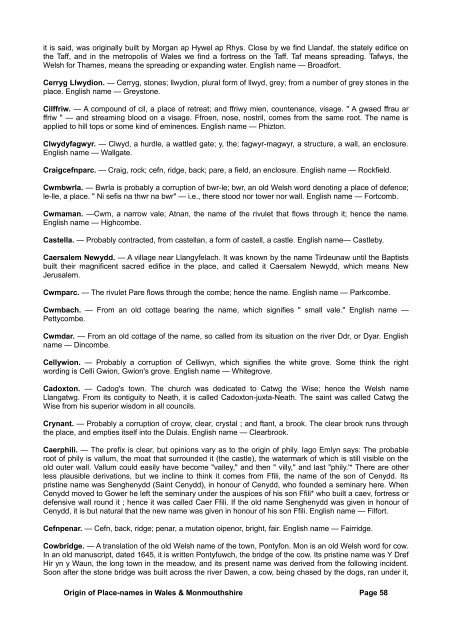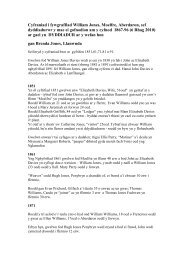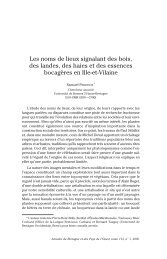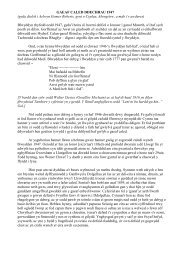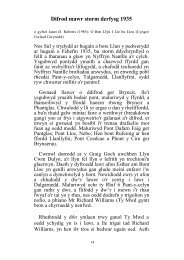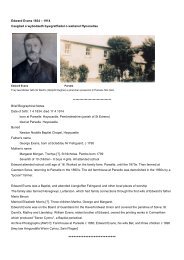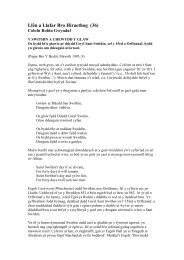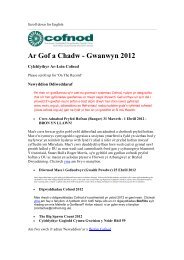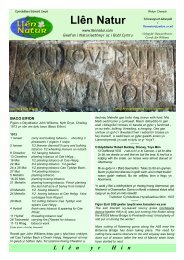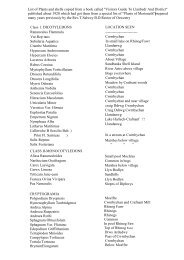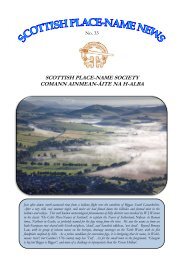name — Spr<strong>in</strong>gton.Blaenycwm. — So called from its situation at <strong>the</strong> extreme end <strong>of</strong> <strong>the</strong> Rhondda Valley. English name —Comb's-end.Bargod. — The full name is Pont-aber-Bargod, signify<strong>in</strong>g <strong>the</strong> bridge near where <strong>the</strong> brook Bargod flows <strong>in</strong>to<strong>the</strong> river Rhymney. Bargod means a spr<strong>in</strong>g<strong>in</strong>g out. English name — Spr<strong>in</strong>gham.Brithdir. — The village takes its name from Cefn Brithdir, <strong>the</strong> name <strong>of</strong> <strong>the</strong> mounta<strong>in</strong> that towers above it.Brithdir means a l<strong>and</strong> <strong>of</strong> medium quality. English name — Midl<strong>and</strong>, or M<strong>in</strong>l<strong>and</strong>.Baglan. — An abbreviation <strong>of</strong> Llanfaglan. The church was dedicated to Baglan, a Welsh sa<strong>in</strong>t <strong>of</strong> <strong>the</strong> sixthcentury.Blaenllechau. — From a farm <strong>of</strong> <strong>the</strong> same name. Ano<strong>the</strong>r farm <strong>in</strong> <strong>the</strong> neighbourhood is called CefnlUchau*The l<strong>and</strong>s <strong>of</strong> both were remarkable for Llechiau y stones. Some call <strong>the</strong> <strong>place</strong> Tre Rhondda, Rhondda townit is also called Ferndale. English name— Stoneby.Boverton. — A corruption <strong>of</strong> Boviutn, <strong>the</strong> name <strong>of</strong> a Roman station which stood near <strong>the</strong> road called JuliaStrata Maritana. There are extensive rema<strong>in</strong>s <strong>of</strong> Roman camps <strong>in</strong> <strong>the</strong> vic<strong>in</strong>ity. In 1798 a considerable number<strong>of</strong> Roman co<strong>in</strong>s were discovered here.Briton Ferry. — In ancient MSS. <strong>the</strong> <strong>place</strong> is called Berton Ferry, <strong>and</strong> Brittane Ferry, <strong>the</strong> ferry where <strong>the</strong>Britons crossed <strong>the</strong> estuary <strong>of</strong> <strong>the</strong> Neath river. Llansawel, <strong>the</strong> Welsh name, is derived by some from llan-isawd,a church under <strong>the</strong> breeze. O<strong>the</strong>rs th<strong>in</strong>k it was dedicated to Sawyl.Barry. — Some th<strong>in</strong>k <strong>the</strong> <strong>place</strong> derives its name from Baruch, a disciple <strong>of</strong> Gilsach, who was buried here <strong>in</strong><strong>the</strong> year 700. O<strong>the</strong>rs th<strong>in</strong>k it is <strong>the</strong> Norse for bare isl<strong>and</strong>.Bridgend. — A translation <strong>of</strong> <strong>the</strong> Welsh Penybont. The full name is Penybont-ar-Ogwy, Bridgend-on-<strong>the</strong>Ogmore.Birchgrove. — From a farm <strong>of</strong> <strong>the</strong> name, whereon <strong>the</strong> village is situated.Bishopston. — In olden times <strong>the</strong> manor belonged to <strong>the</strong> see <strong>of</strong> Ll<strong>and</strong>aff, <strong>and</strong>, on account <strong>of</strong> that, <strong>the</strong> parishreceived its ecclesiastical name. The Welsh name is Ll<strong>and</strong>eilo Ferwallt. The church is dedicated to BishopTeilo. Berwallt is a compound <strong>of</strong> berw, <strong>the</strong> water-cress, <strong>and</strong> gallt, a wooded declivity. In <strong>the</strong> " LiberL<strong>and</strong>avensis " it is called Lanberugall.Blackmill. — A semi-translation <strong>of</strong> <strong>the</strong> Welsh name, Mel<strong>in</strong> Ifan Ddu. Ifan, Evan, was <strong>the</strong> owner <strong>of</strong> <strong>the</strong> mill,<strong>and</strong> he lived <strong>in</strong> a farm called Dai Ifan Ddu hence <strong>the</strong> name.Brynceth<strong>in</strong>. — Bryn, a hill; ceth<strong>in</strong>, dark, terrible frightful. English name— Frighthill.Bonvilstone. — The Welsh name, Tresimwn, <strong>and</strong> <strong>the</strong> English name, Bonvilstone, were bestowed <strong>in</strong> honour<strong>of</strong> Simon Bonvile, <strong>the</strong> chief steward <strong>of</strong> Sir Robert Fitzhamon.Bryntroedgam. — Bryn, a hill; troed, foot; gam-cam, crooked, signify<strong>in</strong>g a <strong>place</strong> at <strong>the</strong> crooked foot <strong>of</strong> a hill.English name — Crookhill.Butetown. — This isolated village, which is situated near Rhymney. received its name <strong>in</strong> honour <strong>of</strong> <strong>the</strong> lateMarquis <strong>of</strong> Bute.Cardiff. — An Anglicism <strong>of</strong> <strong>the</strong> Welsh name Caerdydd, or, more correctly, Caer Daf. Op<strong>in</strong>ions differ as to <strong>the</strong>right word<strong>in</strong>g <strong>of</strong> <strong>the</strong> postfix. Some derive <strong>the</strong> name from Caer Didius, <strong>the</strong> city <strong>of</strong> Didius {Aulus Didius), <strong>the</strong>Roman general, who -comm<strong>and</strong>ed <strong>in</strong> Brita<strong>in</strong> from a.d. 53 to about 57. It is supposed that he built a fortresson <strong>the</strong> Taff, where, from its contiguity to <strong>the</strong> sea, he would have been much less exposed to <strong>the</strong> onsets <strong>of</strong> <strong>the</strong>warlike Silures. As <strong>the</strong> Romans Lat<strong>in</strong>ized British <strong>names</strong> with <strong>in</strong>crements, such as Casivellaunus fromCaswallon, so, on <strong>the</strong> contrary, <strong>the</strong> Britons rejected <strong>the</strong> f<strong>in</strong>al syllable <strong>of</strong> Lat<strong>in</strong> <strong>names</strong> <strong>and</strong> words, as Iwl, fromJulius: Aleg, from Alectus; <strong>and</strong> here (a case <strong>in</strong> po<strong>in</strong>t) Dydd from Didius, whence Caer Dydd. Despite <strong>the</strong>plausibility <strong>of</strong> <strong>the</strong> above derivation, we ra<strong>the</strong>r th<strong>in</strong>k <strong>the</strong> right word<strong>in</strong>g is Caer Daf, a fortress on <strong>the</strong> Taff, which,Orig<strong>in</strong> <strong>of</strong> Place-<strong>names</strong> <strong>in</strong> Wales & Monmouthshire Page 57
it is said, was <strong>orig<strong>in</strong></strong>ally built by Morgan ap Hywel ap Rhys. Close by we f<strong>in</strong>d Ll<strong>and</strong>af, <strong>the</strong> stately edifice on<strong>the</strong> Taff, <strong>and</strong> <strong>in</strong> <strong>the</strong> metropolis <strong>of</strong> Wales we f<strong>in</strong>d a fortress on <strong>the</strong> Taff. Taf means spread<strong>in</strong>g. Tafwys, <strong>the</strong>Welsh for Thames, means <strong>the</strong> spread<strong>in</strong>g or exp<strong>and</strong><strong>in</strong>g water. English name — Broadfort.Cerryg Llwydion. — Cerryg, stones; llwydion, plural form <strong>of</strong> llwyd, grey; from a number <strong>of</strong> grey stones <strong>in</strong> <strong>the</strong><strong>place</strong>. English name — Greystone.Cilffriw. — A compound <strong>of</strong> cil, a <strong>place</strong> <strong>of</strong> retreat; <strong>and</strong> ffriwy mien, countenance, visage. " A gwaed ffrau arffriw " — <strong>and</strong> stream<strong>in</strong>g blood on a visage. Ffroen, nose, nostril, comes from <strong>the</strong> same root. The name isapplied to hill tops or some k<strong>in</strong>d <strong>of</strong> em<strong>in</strong>ences. English name — Phizton.Clwydyfagwyr. — Clwyd, a hurdle, a wattled gate; y, <strong>the</strong>; fagwyr-magwyr, a structure, a wall, an enclosure.English name — Wallgate.Craigcefnparc. — Craig, rock; cefn, ridge, back; pare, a field, an enclosure. English name — Rockfield.Cwmbwrla. — Bwrla is probably a corruption <strong>of</strong> bwr-le; bwr, an old Welsh word denot<strong>in</strong>g a <strong>place</strong> <strong>of</strong> defence;le-lle, a <strong>place</strong>. " Ni sefis na thwr na bwr" — i.e., <strong>the</strong>re stood nor tower nor wall. English name — Fortcomb.Cwmaman. —Cwm, a narrow vale; Atnan, <strong>the</strong> name <strong>of</strong> <strong>the</strong> rivulet that flows through it; hence <strong>the</strong> name.English name — Highcombe.Castella. — Probably contracted, from castellan, a form <strong>of</strong> castell, a castle. English name— Castleby.Caersalem Newydd. — A village near Llangyfelach. It was known by <strong>the</strong> name Tirdeunaw until <strong>the</strong> Baptistsbuilt <strong>the</strong>ir magnificent sacred edifice <strong>in</strong> <strong>the</strong> <strong>place</strong>, <strong>and</strong> called it Caersalem Newydd, which means NewJerusalem.Cwmparc. — The rivulet Pare flows through <strong>the</strong> combe; hence <strong>the</strong> name. English name — Parkcombe.Cwmbach. — From an old cottage bear<strong>in</strong>g <strong>the</strong> name, which signifies " small vale." English name —Pettycombe.Cwmdar. — From an old cottage <strong>of</strong> <strong>the</strong> name, so called from its situation on <strong>the</strong> river Ddr, or Dyar. Englishname — D<strong>in</strong>combe.Cellywion. — Probably a corruption <strong>of</strong> Celliwyn, which signifies <strong>the</strong> white grove. Some th<strong>in</strong>k <strong>the</strong> rightword<strong>in</strong>g is Celli Gwion, Gwion's grove. English name — Whitegrove.Cadoxton. — Cadog's town. The church was dedicated to Catwg <strong>the</strong> Wise; hence <strong>the</strong> Welsh nameLlangatwg. From its contiguity to Neath, it is called Cadoxton-juxta-Neath. The sa<strong>in</strong>t was called Catwg <strong>the</strong>Wise from his superior wisdom <strong>in</strong> all councils.Crynant. — Probably a corruption <strong>of</strong> croyw, clear, crystal ; <strong>and</strong> ftant, a brook. The clear brook runs through<strong>the</strong> <strong>place</strong>, <strong>and</strong> empties itself <strong>in</strong>to <strong>the</strong> Dulais. English name — Clearbrook.Caerphili. — The prefix is clear, but op<strong>in</strong>ions vary as to <strong>the</strong> <strong>orig<strong>in</strong></strong> <strong>of</strong> phily. Iago Emlyn says: The probableroot <strong>of</strong> phily is vallum, <strong>the</strong> moat that surrounded it (<strong>the</strong> castle), <strong>the</strong> watermark <strong>of</strong> which is still visible on <strong>the</strong>old outer wall. Vallum could easily have become "valley," <strong>and</strong> <strong>the</strong>n " villy," <strong>and</strong> last "phily.'* There are o<strong>the</strong>rless plausible derivations, but we <strong>in</strong>cl<strong>in</strong>e to th<strong>in</strong>k it comes from Ffili, <strong>the</strong> name <strong>of</strong> <strong>the</strong> son <strong>of</strong> Cenydd. Itsprist<strong>in</strong>e name was Senghenydd (Sa<strong>in</strong>t Cenydd), <strong>in</strong> honour <strong>of</strong> Cenydd, who founded a sem<strong>in</strong>ary here. WhenCenydd moved to Gower he left <strong>the</strong> sem<strong>in</strong>ary under <strong>the</strong> auspices <strong>of</strong> his son Ffili* who built a caev, fortress ordefensive wall round it ; hence it was called Caer Ffili. If <strong>the</strong> old name Senghenydd was given <strong>in</strong> honour <strong>of</strong>Cenydd, it is but natural that <strong>the</strong> new name was given <strong>in</strong> honour <strong>of</strong> his son Ffili. English name — Filfort.Cefnpenar. — Cefn, back, ridge; penar, a mutation oipenor, bright, fair. English name — Fairridge.Cowbridge. — A translation <strong>of</strong> <strong>the</strong> old Welsh name <strong>of</strong> <strong>the</strong> town, Pontyfon. Mon is an old Welsh word for cow.In an old manuscript, dated 1645, it is written Pontyfuwch, <strong>the</strong> bridge <strong>of</strong> <strong>the</strong> cow. Its prist<strong>in</strong>e name was Y DrefHir yn y Waun, <strong>the</strong> long town <strong>in</strong> <strong>the</strong> meadow, <strong>and</strong> its present name was derived from <strong>the</strong> follow<strong>in</strong>g <strong>in</strong>cident.Soon after <strong>the</strong> stone bridge was built across <strong>the</strong> river Dawen, a cow, be<strong>in</strong>g chased by <strong>the</strong> dogs, ran under it,Orig<strong>in</strong> <strong>of</strong> Place-<strong>names</strong> <strong>in</strong> Wales & Monmouthshire Page 58
- Page 1 and 2:
HANDBOOK OF THE ORIGIN OF PLACE-NAM
- Page 3 and 4:
§ § § § §The Author begs to st
- Page 5 and 6:
pitiful cries of the railway offici
- Page 7 and 8:
Bishop Percy says that "in England,
- Page 9 and 10: The city of Chester is still popula
- Page 11 and 12: There's Cumwhitton, Cumwhinton, Cum
- Page 13 and 14: Llwyn in its primary' sense means a
- Page 15 and 16: PLACE-NAMES IN WALES.Wales. — The
- Page 17 and 18: Church are generally dedicated to e
- Page 19 and 20: think he was a contemporary of St.
- Page 21 and 22: Rhosbeirio. — Rhos, a moor, a dry
- Page 23 and 24: of Brecknock," states that this vic
- Page 25 and 26: Cam cnwir ef Cwmdu,Cwm gwyn yw & n
- Page 27 and 28: Penderyn. — A corruption probably
- Page 29 and 30: Ardudwy. — Ar, upon or above; tud
- Page 31 and 32: to mark its pre-eminence over the o
- Page 33 and 34: Some think that eirw is a corruptio
- Page 35 and 36: present form — Caerfyrddin.Abergw
- Page 37 and 38: place of refuge; hence the name. En
- Page 39 and 40: Llansawyl. — The church was dedic
- Page 41 and 42: eject. The village took its name fr
- Page 43 and 44: house, and attempted to kill an inf
- Page 45 and 46: Gwydir. — Prima facie one may tak
- Page 47 and 48: Nefyn. — The church was probably
- Page 49 and 50: DENBIGHSHIRE.Anglicized form of Din
- Page 51 and 52: Llangollen. — From Collen, a sain
- Page 53 and 54: hands into their pockets to pay a c
- Page 55 and 56: Cefn. — The name signifies a ridg
- Page 57 and 58: Maesgarmon. — Named in honour of
- Page 59: Abertridwr. — Tridwr, three water
- Page 63 and 64: Cwmllynfell. — Cwm, a narrow vale
- Page 65 and 66: Gwarycaeau. — Gwdr, the nape of t
- Page 67 and 68: means a cultivated region, a vale,
- Page 69 and 70: Penrhiwfer.- Pen, head, top; rhiw,
- Page 71 and 72: Port Talbot. — So called in 1835
- Page 73 and 74: Trealaw. — This appellation was g
- Page 75 and 76: Aberdyfi. — So called from its si
- Page 77 and 78: Llanddwywe. — From Dwywau, a desc
- Page 79 and 80: Crickhowell and some in the directi
- Page 81 and 82: Griffithstown. — This village was
- Page 83 and 84: and gwy, water. Treiddiod troth tna
- Page 85 and 86: derive Tintern from din, fortified
- Page 87 and 88: Caersws. — It appears that the Ro
- Page 89 and 90: English name — Ervylton.Llanymech
- Page 91 and 92: Angle. — Probably from the angle-
- Page 93 and 94: Gellyswick. — Another hybrid. Gel
- Page 95 and 96: that the two rivers in their flowin
- Page 97 and 98: ecame the bishop of the see, and wa
- Page 99 and 100: earth formerly stood on a summit on
- Page 101 and 102: Pilleth. — A corruption of pwll,
- Page 103 and 104: Howells, Rev. J., Mountain AshHowel
- Page 105 and 106: Williams, D., PenywernWilliams, Rev


